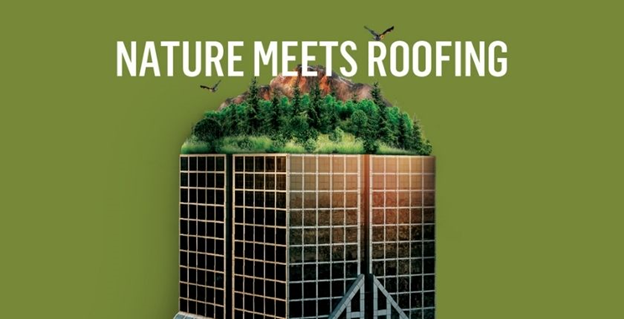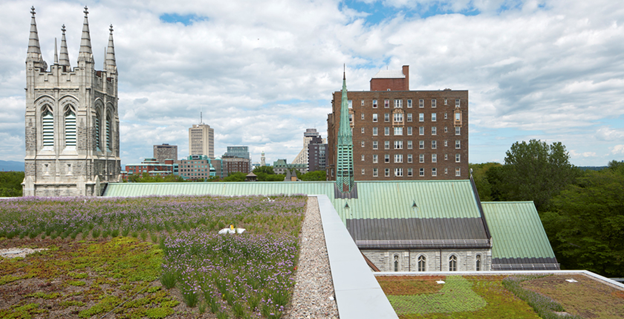A Q&A With Jamie Dwyer
The concept of biomimicry is gaining traction within the building community. It describes an approach to developing built environments with materials, structures, and systems (e.g. roofs) that imitate and respect their natural surroundings.
No doubt, biomimicry is a fitting topic for these eco-conscious times. Below, Jamie Dwyer, Principal of Research and Design with Biomimicry 3.8, discusses what it means to make buildings part of the ecosystem and how industry builders, designers, manufacturers and suppliers can play a role.
DISCOVER OUR SOPRANATURE PRODUCT LINE
Why Should We Consider Buildings as Part of an Ecosystem?
Oxford defines an ecosystem as “a biological community of interacting organisms and their physical environment.” So, by that definition, buildings are certainly part of the ecosystem. Each one affects the environment and species around it, and in return, the environment and neighboring species affect our buildings.
Like it or not, buildings become part of the system. Most often, however, they create environmental problems by reducing the amount of functioning habitat within our cities, which leads to issues such as flooding, the heat island effect, and factors that contribute to climate change. Cities need their built spaces to function like healthy ecosystems. We need buildings to help sequester carbon, manage floodwaters, clean water, or clean the air. They don’t have to look like they are mimicking nature, but we need them to positively contribute to the system.
How Can Biomimicry Influence the Building?
Biomimicry can inspire forms, processes, or systems. Certainly, biomimicry can influence the overall shape of a building, but inspiration from nature can also change the design of the mechanical systems, the landscaping, the structure, or the façade. Biomimicry can even guide the goals for building performance. For form, process or system, nature can inspire design ideas for buildings on multiple levels.
DISCOVER OUR SOPRANATURE PRODUCT LINE
Can We Adapt to Climate Change in North America by Focusing On Biomimicry?
I think biomimicry is a helpful process to use when tackling resilience and climate change in the built environment. Again, if buildings can have a positive impact, we can make our cities more resilient in the face of climate change.
What Would Be the Perfect Material for a Building If We Get Inspired By Nature?
Many biomimetic solutions can be made with current materials – ideas that use current materials in a new way or for a different intent. Other times, a new material might be needed to fully realize a new idea. In these instances, a collaboration between the design team and a manufacturer would be the best way to implement the design.
How Has the Architectural Community Responded to the Idea of Biomimicry? Do They Include It in Their Designs for Renovations and New Construction?
Architects are definitely interested in biomimicry. Biomimicry 3.8 has been doing biomimicry consulting with architecture firms for almost two decades to help architects bring design strategies from nature into their projects. I have seen architects incorporate biomimicry in new construction as well as renovations.
Is There a Possible Collaboration Between the Architect and Manufacturers Like SOPREMA to Innovate?
As designers reimagine what they want buildings to do and how they want them to perform, materials start to be used in ways that are different from the initial intention of the material. Roofing, waterproofing and wall protection are all part of building systems that interact with the environment, so it’s a great place to start innovating with biomimicry.
DISCOVER OUR SOPRANATURE PRODUCT LINE
What Do You Think About the Living Building Challenge Certification as a Way to Promote Biomimicry?
Biomimicry 3.8 has been working in collaboration with the International Living Future Institute. There are a couple of instances where biomimicry has been added into the language of the imperatives of the Living Building Challenge and the Living Community Challenge. The Living Building Challenge is certainly in alignment with the work Biomimicry 3.8 is doing in the built environment.
Overall, How Would You Describe the Building Of Tomorrow?
I think the building of tomorrow should be functionally indistinguishable from a healthy ecosystem. We have a real opportunity to change the intent of our buildings. We can design buildings that are more than just beautiful spaces that protect us from the elements. As designers, we have a responsibility to create buildings that have a positive impact on the places where we build.
Biomimicry is one of the ways used by SOPREMA’s collaborators to imagine, design, and develop their products and systems. Taking inspiration from nature helps us find sustainable solutions to change buildings and infrastructure in their environment. For example, SOPRANATURE systems, by integrating nature permanently into the built environment, will help meet many of tomorrow’s challenges and solve a multitude of current issues affecting both building owners and communities.
ABOUT JAMIE DWYER
Jamie Dwyer is a biomimicry researcher and design principal for Biomimicry 3.8. She is a Certified Biomimicry Professional, having earned her Masters of Science in Biomimicry after earning degrees in biology and architecture—two seemingly divergent fields that are perfectly united through the practice of biomimicry.
As a client services project manager and lead researcher for Biomimicry 3.8, Jamie facilitates biomimicry in the built environment. She works to transform the design framework by helping designers apply biological intelligence derived from nature’s forms, processes, and systems. In addition, Jamie has served as a biologist at the design table for major clients like Kimberly Clark, Terrapin Bright Green, BNIM, Jacobs Engineering, and HOK.
Jamie also teaches biomimicry courses and workshops, including as the co-instructor for the Inspired by Nature: Biomimicry for the Built Environment training in San Francisco, and Discovering Nature’s Genius immersion workshop in Montana.
She has been a featured speaker at numerous events including the Living Future unConference, the Living Product Expo, Singapore USGBC, and the MT USGBC Summit.
Jamie is an avid birder with a new found interest in learning to watercolor. She lives in Helena, Montana, with her husband and two daughters, who make sure life at home is always a musical.





